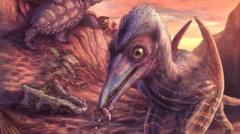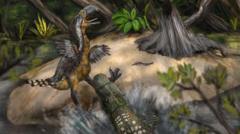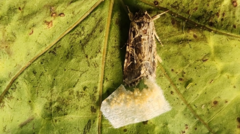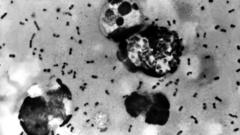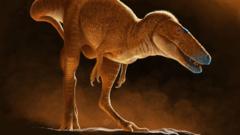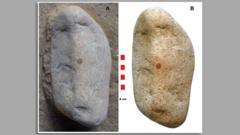The recent identification of a new pterosaur species, named Eotephradactylus mcintireae, has stirred excitement among paleontologists. This flying reptile, which lived over 200 million years ago, was discovered from a jawbone unearthed in Arizona back in 2011. Recent advancements in scanning technology have allowed researchers to confirm that it belongs to a previously unknown species.
Eotephradactylus mcintireae, whose name translates to "ash-winged dawn goddess," highlights the volcanic ash that helped preserve its fossilized remains in an ancient riverbed. The research, conducted by a team from the Smithsonian's National Museum of Natural History in Washington, D.C., published findings in the esteemed journal Proceedings of the National Academy of Sciences.
At around 209 million years old, this discovery marks the earliest known pterosaur in North America. Dr. Ben Kligman from the research team explained that the delicate and hollow bones of Triassic pterosaurs often perish before the fossilization process, making this find particularly significant. The fossil was located in a desert landscape that, during the Triassic period, functioned as a river containing layers of sediment that preserved various ancient life forms.
The bone bed where the pterosaur's jaw was found also contains an intriguing array of other fossils, including teeth and scales from fish, as well as coprolites, or fossilized waste. The pterosaur's teeth indicate that it likely fed on hard-bodied prey, possibly early fish armored with bony scales.
The discovery site provides a snapshot of an ancient ecosystem, showcasing a blend of extinct creatures such as giant amphibians alongside more recognizable species like frogs and turtles. Dr. Kligman emphasized that this fossil assembly reflects an evolutionary transitional phase, where historically significant animal groups co-existed with their ancient counterparts. Such fossil beds serve as crucial evidence that allows scientists to piece together the complex tapestry of life that existed on the planet over 200 million years ago.
Eotephradactylus mcintireae, whose name translates to "ash-winged dawn goddess," highlights the volcanic ash that helped preserve its fossilized remains in an ancient riverbed. The research, conducted by a team from the Smithsonian's National Museum of Natural History in Washington, D.C., published findings in the esteemed journal Proceedings of the National Academy of Sciences.
At around 209 million years old, this discovery marks the earliest known pterosaur in North America. Dr. Ben Kligman from the research team explained that the delicate and hollow bones of Triassic pterosaurs often perish before the fossilization process, making this find particularly significant. The fossil was located in a desert landscape that, during the Triassic period, functioned as a river containing layers of sediment that preserved various ancient life forms.
The bone bed where the pterosaur's jaw was found also contains an intriguing array of other fossils, including teeth and scales from fish, as well as coprolites, or fossilized waste. The pterosaur's teeth indicate that it likely fed on hard-bodied prey, possibly early fish armored with bony scales.
The discovery site provides a snapshot of an ancient ecosystem, showcasing a blend of extinct creatures such as giant amphibians alongside more recognizable species like frogs and turtles. Dr. Kligman emphasized that this fossil assembly reflects an evolutionary transitional phase, where historically significant animal groups co-existed with their ancient counterparts. Such fossil beds serve as crucial evidence that allows scientists to piece together the complex tapestry of life that existed on the planet over 200 million years ago.

